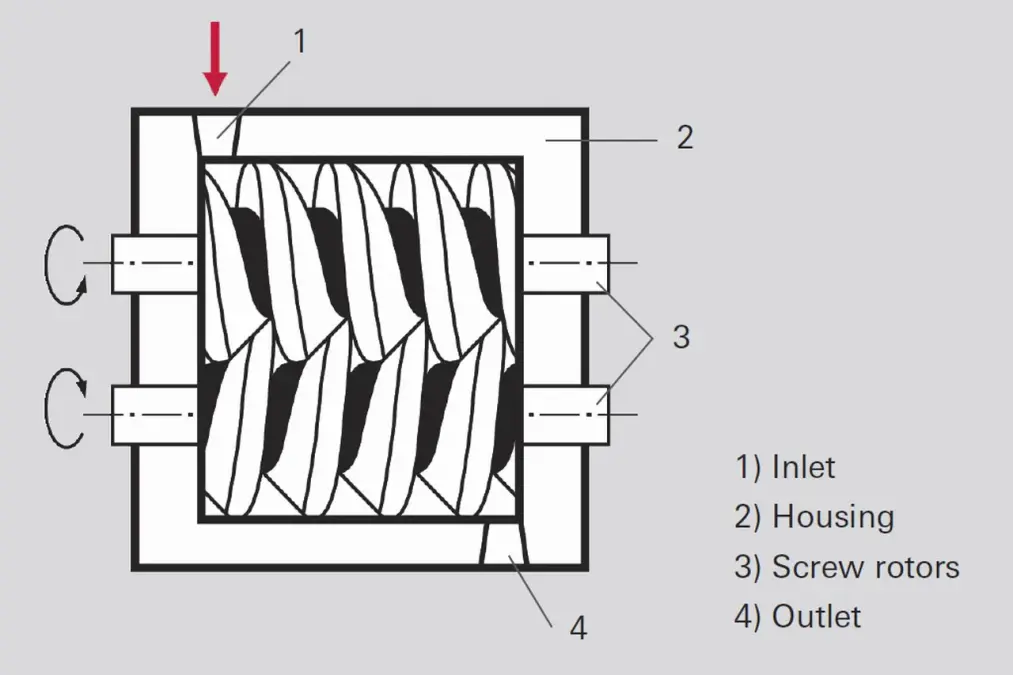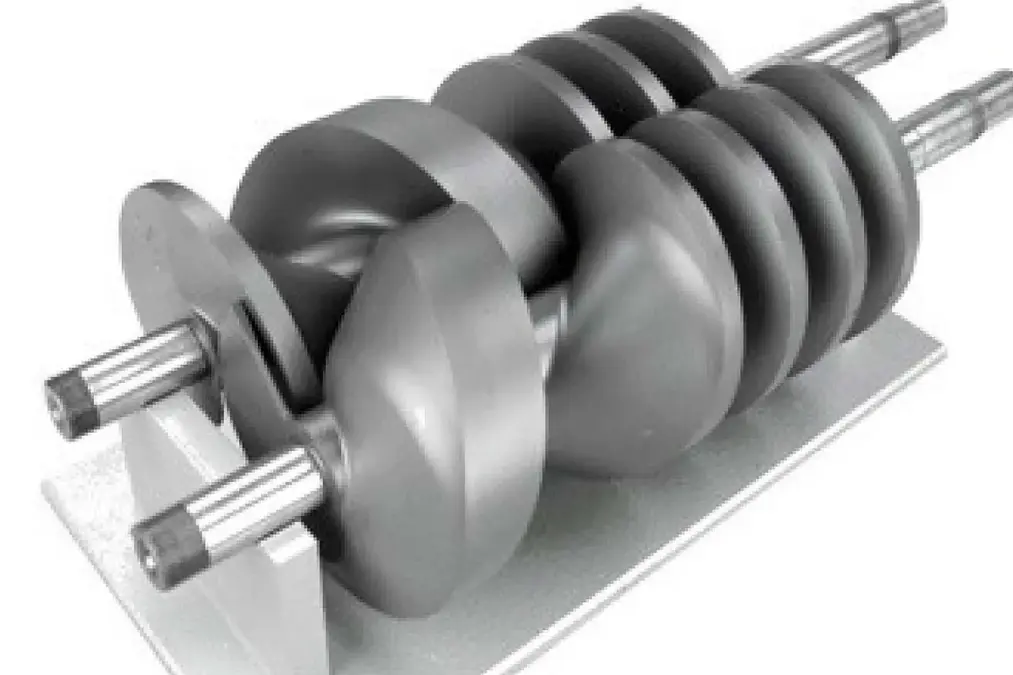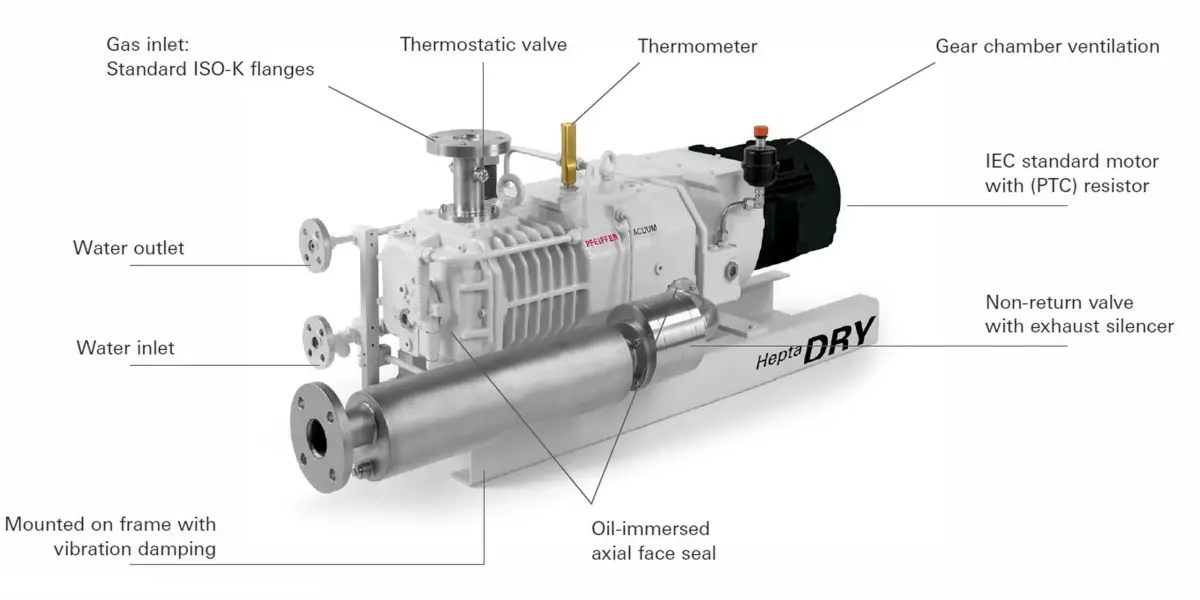-

Figure 4.6: Operating principle of a screw pump
-

Figure 4.7: Screw pump rotors
Because the dissipated energy that is generated by the pulsing gas flow heats the pump on the outlet side, cooling is required at precisely this location. The gap between housing and rotors is a function of the temperature differential between the warmer rotors and the cooled housing. The amount of heat produced and the temperature are a function of the inlet pressure range. Temperatures are lowest at high inlet pressures (nearly atmospheric), as virtually no compression work is performed here and the displaced air transports sufficient heat out of the pump. In addition, the high gas flow also prevents oscillation of the gas in the last stage. During operation at ultimate pressure (p < 1 hPa), the oscillation of the atmospheric air produces higher temperatures at the outlet area, since no gas is passing through the pump and therefore no heat is being transported out of the pump.
HeptaDry pumps are dry screw pumps with internal compression. The screw rotors have a symmetrical geometry with variable pitch. These pumps do not have an end plate with control openings; instead, the gas is discharged axially against atmospheric pressure. Because of the internal compression, the volume of pulsing gas is low.
This results in lower power consumption, quiet operating, uniform temperature distribution within the pump and low cooling water consumption. This makes these pumps extremely cost-effective, in spite of their robust design.
HeptaDry pumps are dry screw pumps with internal compression. The screw rotors have a symmetrical geometry with variable pitch. These pumps do not have an end plate with control openings; instead, the gas is discharged axially against atmospheric pressure. Because of the internal compression, the volume of pulsing gas is low.
This results in lower power consumption, quiet operating, uniform temperature distribution within the pump and low cooling water consumption. This makes these pumps extremely cost-effective, in spite of their robust design.
4.4.2 Application
In recent years, water cooled screw pumps and the multi-stage roots pumps described in the following section have been replacing more and more the previously dominating oil-lubricated rotary vane pump in the high pumping speed segment (100 – 600 m³ · h-1).Advantages of screw pumps include:
- No lubricant in the gas displacement area
- No contamination of the medium to be pumped
- No operating fluid disposal problems
- Higher efficiency due to internal compression
- Virtually constant pumping speed between 1 and 1,000 hPa.
- Good liquid and dust tolerance
- Ideal backing pump for vacuum boosters
This makes HeptaDry screw pumps very well suited for chemical applications or processes that generate dust, e. g. for crystal growing or if significant volumes of condensate are produced.
In thermostatic cooling, the water flow volume will depend on the following parameters: inlet pressure, gas type, rotation speed and pump size. Due to the waterflow cooling, virtually no heat is dissipated to the atmosphere. This reduce the heat load on any existing air conditioning systems and reduce their energy consumption.
Overview of primary screw pump applications:
- Drying, freeze-drying
- Electron beam welding
- Metallurgy
- Coating
- Load locks
- Chemical applications
-

Figure 4.8: HeptaDry with connections and accessories
4.4.3 Portfolio overview
HeptaDry pumps are dry screw pumps for applications in the low and medium vacuum ranges where high volume flow rates are required. The pumping speeds of this product line range from 100 to 600 m3 · h-1. Ultimate pressures of under 0.1 hPa are attained. Their pumping speed and the attainable final pressure depend on the mains frequency.Regardless of the model in question, HeptaDry pumps can be continuously operated in their particular operating range. Their effective pumping speed declines in the p < 1 hPa pressure range due to the ever-stronger backflow between the individual sealed volumes within the pump. There is a similar reason for the decrease in pumping speed toward high pressure, as in this case the gas is compressed to pressures in excess of atmospheric pressure through internal compression, and consequently backflow increases significantly due to the high differential pressure.
The standard equipment that comes with the pumps includes: inlet sieve, water-flow cooling with thermostatic valve and thermometer, silencer with non-return valve and frame-mounted design with vibration dampers. The pumps are driven by a three-phase, temperature-monitored asynchronous motor that is suitable for 50 and 60 Hz (3,000 or 3,600 rpm).
4.4.4 Accessories
Dust separators (SAS) are available as an accessory for the screw pumps. There are various types available to fit the connection flange on the pump.D1 type Diester oil is used as operating fluid.
HeptaDry series | ||||
|---|---|---|---|---|
Model | Pumping speed at 50Hz | Pumping speed at 60Hz | Ultimate pressure at 50Hz | Ultimate pressure at 60Hz |
Hepta 100 P | 110 m³ · h-1 | 130 m³ · h-1 | < 5 · 10-2 hPa | < 1 · 10-2 hPa |
Hepta 100 P | 110 m³ · h-1 | 130 m³ · h-1 | < 5 · 10-2 hPa | < 1 · 10-2 hPa |
Hepta 100 P | 110 m³ · h-1 | 130 m³ · h-1 | < 5 · 10-2 hPa | < 1 · 10-2 hPa |
Hepta 100 P | 110 m³ · h-1 | 130 m³ · h-1 | < 5 · 10-2 hPa | < 1 · 10-2 hPa |
Hepta 100 P | 110 m³ · h-1 | 130 m³ · h-1 | < 5 · 10-2 hPa | < 1 · 10-2 hPa |
Table 4.13: HeptaDry performance data